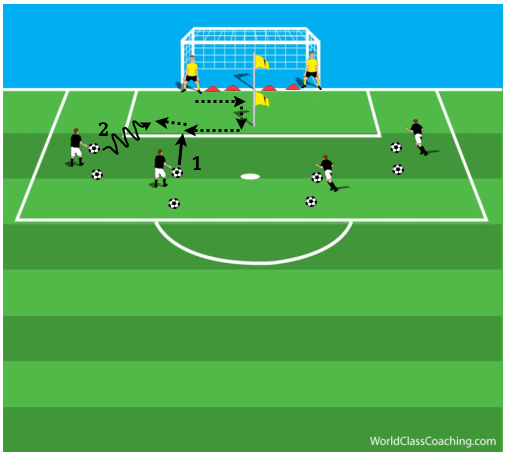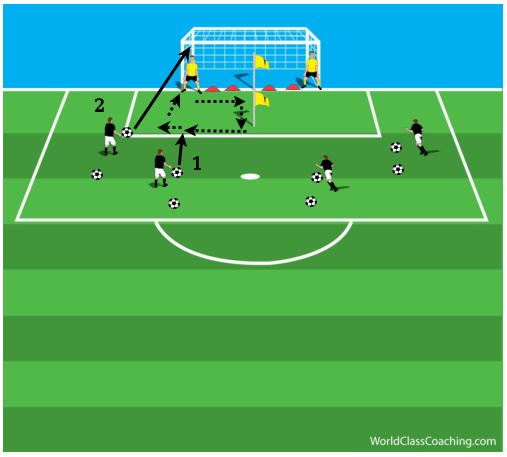By Tony Englund -
Experienced, advanced goalkeepers sometimes fail to train on their edge if they are continually subjected to the same, rote technical training exercises. An engaging, challenging method of combating this complacency is to put the goalkeeper in an environment where they are forced to make multiple saves in tight, particularly where there is a recovery save involved. This article offers a pair of scenarios where goalkeepers can be compelled to work on their edge and make multiple difficult, if confidence-building saves.
Meat Grinder
Multiple Save, Reaction Training.

The base set up for this exercise requires a large ball supply and a goal divided in half, as well as a pair of shooters for each side of the goal. The goalkeeper starts with a hand on the post. He does footwork (usually two steps between cones, but jumping or zig-zagging are also effective here) through the cones or ladder to the center of the goal, where he touches a flag, steps forward to touch another flag and then makes a diving save back toward the post before recovering to stop a driven ball toward the same post by the other shooter. We often use this exercise in a club training setting, as it is efficient for 4 or more goalkeepers (using both sides of the goal). Note that goalkeepers need to rotate sides of the goal so that they dive both sides.
Coach
- Clean, efficient footwork as the goalkeeper moves and particularly as he tires.
- A low, hard push to make the first save (the shooters need to drive the ball low, just inside the post).
- Quick recovery after the first save.
- Aggressive footwork and a set posture to take away the second shot (again, the shooters must try to drive the ball between the goalkeeper and the near post).
- The near-post save is challenging in a recovery setting because many goalkeepers fail to get a push forward and wind up worrying about colliding with the post. If this problem persists, place a marker beyond which the goalkeeper must advance before the second shot is taken.
 Variation #1
Variation #1
The second shooter now has the option to shoot or try to dribble the goalkeeper. This is a realistic and difficult save for the goalkeeper, who may see this dilemma after a deflection or a rebound. Emphasize getting forward after the first save and looking for an opportunity to get into the dribbler’s feet to take the ball away, or at least getting close enough to block the shot.

Variation #2
The second shooter is now a server who waits for the goalkeeper to recover to his feet after the first save and then tosses an arced ball up under the crossbar for the goalkeeper to recover and save or tip. Once again, this situation can occur after a first save or a deflection and the goalkeeper must read perform proper footwork (drop-step and shuffle to the line) and then decide whether the ball can be caught or should be tucked over the bar by the trailing hand.
Other Variations
- The first shooter is free to shoot anywhere on the relevant side of the goal. This teaches the goalkeeper not to just dive, but read play. It is advisable to back off the shooter to 15 yards when using this variation.
- The first shooter is a dribbler and the second shooter is a shooter. This is realistic recovery training for a blocking save on a breakaway.
- The first shooter tries to chip the goalkeeper from 20+ yards and the second shooter is a dribbler. Simulates a high ball save and recovery to deal with a rebound.
This is a tough, but fun goalkeeper training environment that offers much flexibility for intensive in-tight save situations. These exercises put technique under pressure, allowing the coach ample opportunity to build good habits in their goalkeepers. In the second article in this series, we will look at combining shots from more distance and constantly varying angles.
By Tony Englund - Holds an NSCAA Premier License and 11 other diplomas. Tony has presented goalkeeping clinics for the NSCAA and is the author of six books including: Goalie Wars! and Art of the Duel


